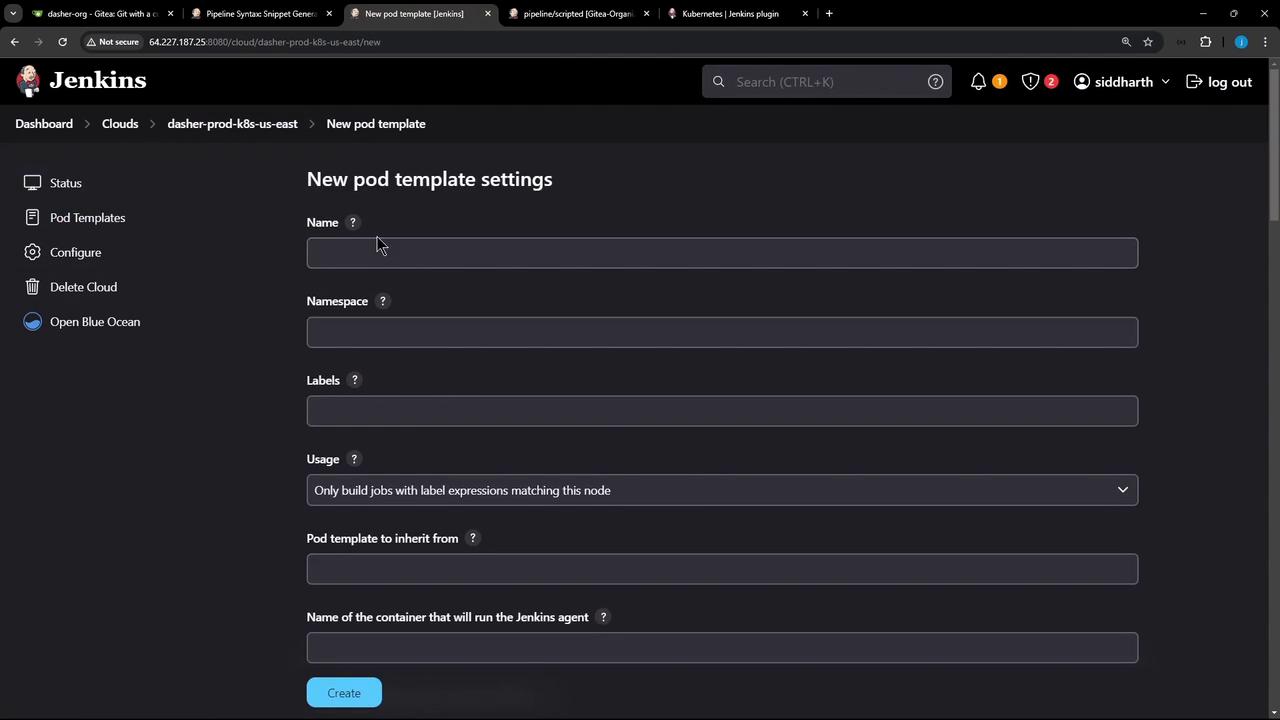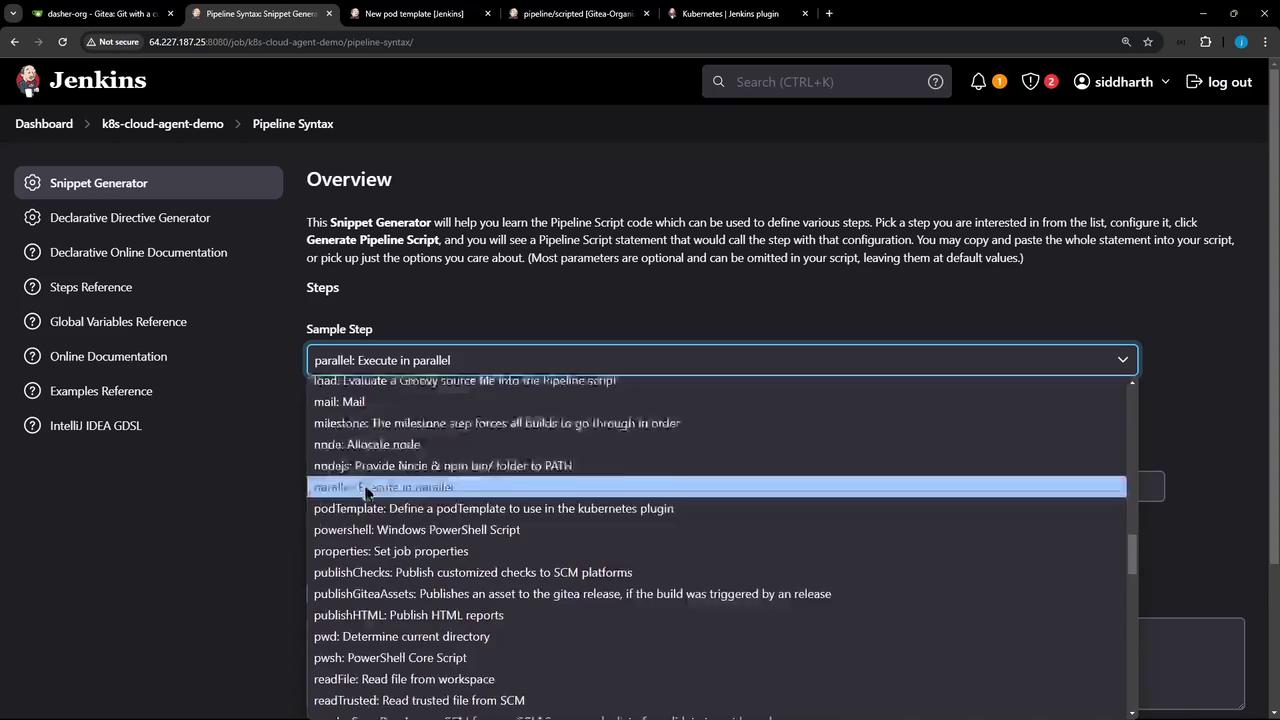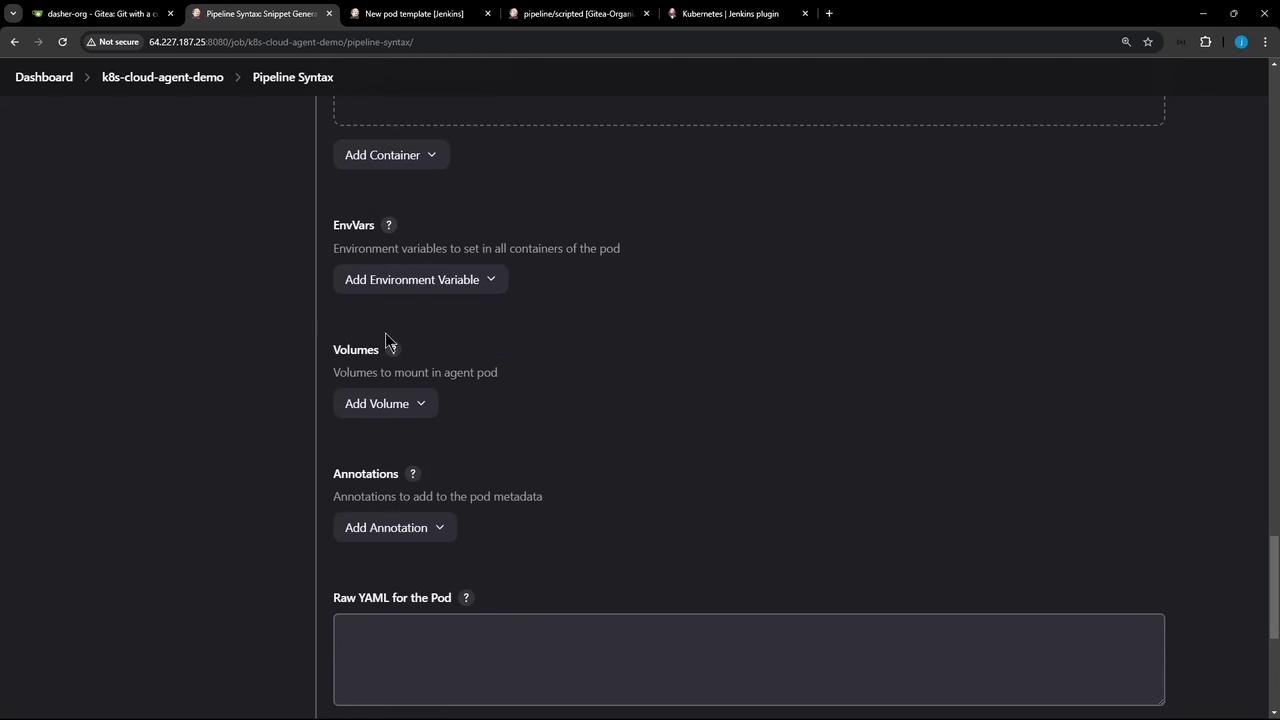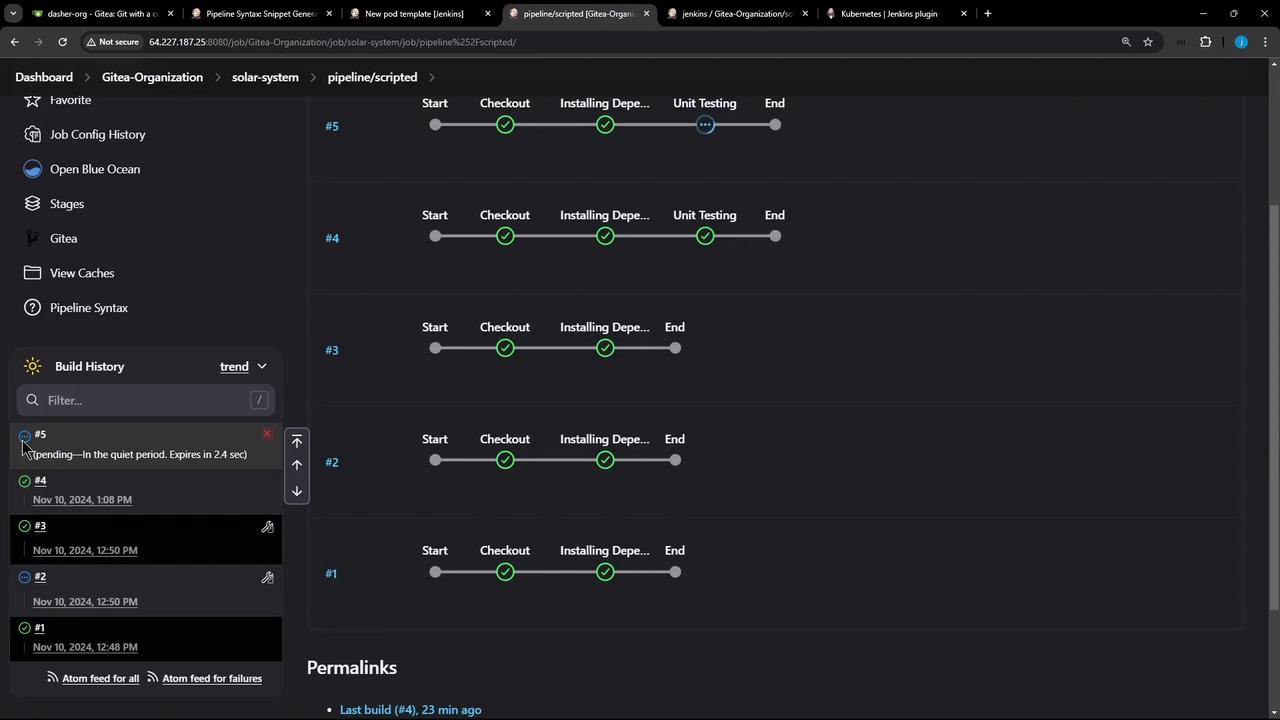Certified Jenkins Engineer
Pipeline Structure and Scripted vs Declarative
Demo Scripted Pipeline K8S Agent
In this tutorial, we’ll show you how to run Jenkins scripted pipelines inside Kubernetes pods using podTemplate and node(POD_LABEL). This approach dynamically spins up isolated build environments, improving resource usage and build consistency.
Table of Contents
- Scripted
podTemplateBasics - Advanced Pod Template with Multiple Containers
- Generating a
podTemplatewith Snippet Generator - Complete Scripted Pipeline Example
- Observing Pod Creation and Logs
- Common Pitfalls
- Links and References
Scripted podTemplate Basics {#scripted-podtemplate-basics}
A minimal scripted pipeline using a Kubernetes agent:
podTemplate {
node(POD_LABEL) {
// pipeline steps...
}
}
podTemplate: Defines the pod configuration.node(POD_LABEL): Executes steps inside the dynamically created pod.
Advanced Pod Template with Multiple Containers {#advanced-pod-template}
You can run different build tools side by side. For example, a Maven container and a Golang container:
podTemplate(
agentContainer: 'maven',
agentInjection: true,
containers: [
containerTemplate(
name: 'maven',
image: 'maven:3.9.9-eclipse-temurin-17'
),
containerTemplate(
name: 'golang',
image: 'golang:1.16.5',
command: 'sleep',
args: '99d'
)
]
) {
node(POD_LABEL) {
stage('Build Maven Project') {
git 'https://github.com/jenkinsci/kubernetes-plugin.git'
container('maven') {
sh 'mvn -B -ntp clean install'
}
}
stage('Build Go Project') {
git url: 'https://github.com/hashicorp/terraform.git', branch: 'main'
container('golang') {
sh '''
mkdir -p /go/src/github.com/hashicorp
ln -s `pwd` /go/src/github.com/hashicorp/terraform
cd /go/src/github.com/hashicorp/terraform
make
'''
}
}
}
}
This defines two containerTemplate entries and injects Maven as the default container.
Generating a podTemplate with Snippet Generator {#snippet-generator}
Use Jenkins’ Snippet Generator to bootstrap your podTemplate:
- Go to Manage Jenkins ▶️ Snippet Generator
- Select podTemplate under Sample Steps
- Choose your Kubernetes cloud, then set:
- Name (optional)
- Namespace
- Label (e.g.,
nodejs-pod)
- Click Add Container Template, and fill in:
| Field | Value |
|---|---|
| Name | node-18 |
| Docker image | node:18-alpine |
| Command | sleep |
| Arguments | 9999999 |
| Allocate pseudo-TTY | ✓ |
| Privileged | ✓ |

Trim the generated block to include only necessary fields:
podTemplate(
cloud: 'dasher-prod-k8s-us-east',
label: 'nodejs-pod',
containers: [
containerTemplate(
name: 'node-18',
image: 'node:18-alpine',
command: 'sleep',
args: '9999999',
privileged: true,
ttyEnabled: true
)
]
) {
// your scripted pipeline here
}



Full Scripted Pipeline Example {#full-scripted-pipeline}
Here’s a complete Jenkinsfile mixing a static Ubuntu agent for checkout and dependency install, then a Kubernetes pod for unit tests:
node('ubuntu-docker-jdk17-node20') {
// Setup environment
env.NODEJS_HOME = tool('nodejs-22-6-0')
env.PATH = "${env.NODEJS_HOME}/bin:${env.PATH}"
env.MONGO_URI = "mongodb+srv://supercluster.d83jj.mongodb.net/superData"
properties([])
stage('Checkout') {
checkout scm
}
wrap([$class: 'TimestampedBuildWrapper']) {
stage('Install Dependencies') {
cache(maxCacheSize: 550, caches: [
arbitraryFileCache(
cacheName: 'npm-dependency-cache',
cacheValidityDecidingFile: 'package-lock.json',
includes: ['**/*'],
path: 'node_modules'
)
])
sh 'node -v'
sh 'npm install --no-audit'
stash includes: 'node_modules/', name: 'npm-cache'
}
}
stage('Unit Testing') {
podTemplate(
cloud: 'dasher-prod-k8s-us-east',
label: 'nodejs-pod',
containers: [
containerTemplate(
name: 'node-18',
image: 'node:18-alpine',
command: 'sleep',
args: '9999999',
privileged: true,
ttyEnabled: true
)
]
) {
node('nodejs-pod') {
container('node-18') {
checkout scm
unstash 'npm-cache'
withCredentials([usernamePassword(
credentialsId: 'mongo-db-credentials',
usernameVariable: 'MONGO_USERNAME',
passwordVariable: 'MONGO_PASSWORD'
)]) {
sh 'node -v'
sh 'npm test'
}
}
}
}
}
}
Commit and push:
git checkout -b pipeline/scripted
git add Jenkinsfile
git commit -m "Add scripted pipeline with Kubernetes pod for unit tests"
git push -u origin pipeline/scripted
Observing Pod Creation and Logs {#observing-pods}
Once the pipeline runs, the nodejs-pod appears in Blue Ocean or the classic UI:

Inspect the generated pod YAML in the console log:
[Pipeline] { (Unit Testing)
[Pipeline] node
Created pod: dasher-prod-k8s-us-east jenkins/nodejs-pod-xxxxx-yyyyy
...
spec:
containers:
- name: node-18
image: node:18-alpine
command: ["sleep"]
args: ["9999999"]
securityContext:
privileged: true
tty: true
volumeMounts:
- mountPath: "/home/jenkins/agent"
name: "workspace-volume"
Common Pitfalls {#common-pitfalls}
- Missing
checkout scminside thenode('nodejs-pod')block results in an empty workspace. - Always
stashandunstashdependencies when switching agents (e.g.,node_modules). - Verify container images include all required tools (Node.js, Mongo CLI, etc.).
Warning
Forgetting to checkout scm or unstash dependencies will cause failures inside the Kubernetes pod due to missing files.
Links and References {#links-and-references}
Watch Video
Watch video content